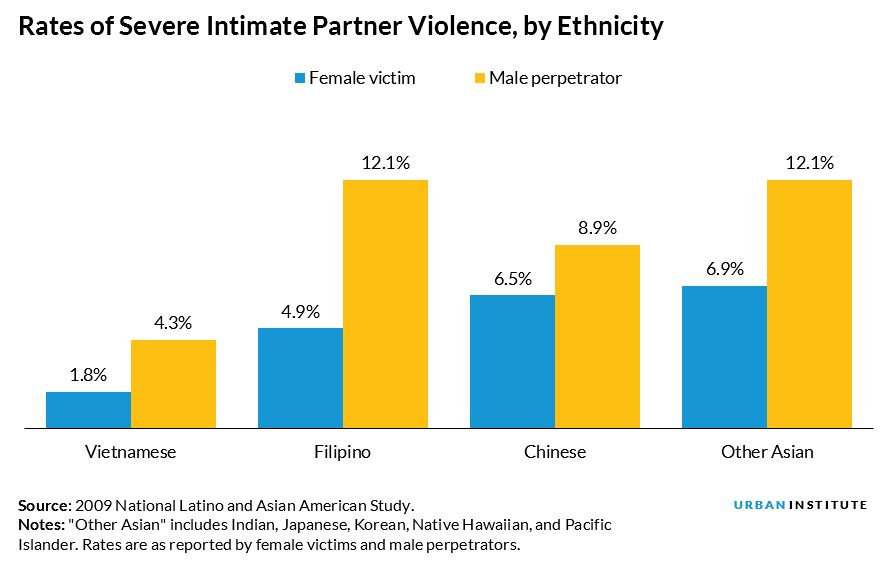
<p>Photo via Shutterstock.</p>
The #MeToo movement has shed light on the violence and victimization some women face in professional settings and personal relationships. Although many high-profile cases have involved powerful men engaging in sexual harassment and assault in the workplace, it is important to note that victimization of women occurs in a wide range of contexts involving different types of relationships and forms of violence. As we acknowledge and reckon with these problems, we still face gaps in understanding how they manifest in certain marginalized communities.
As Asian Pacific American Heritage Month comes to a close, we sharpen the focus on how intimate partner violence (IPV) affects Asian Americans and Pacific Islanders (AAPIs), a group around which there remains silence and uncertainty about the issue.
Intimate partner violence rates appear to be lower among AAPI women…
Findings from the 2010 National Intimate Partner and Sexual Violence Study reveal that about one in five AAPI women reported experiencing rape, physical violence, or stalking by an intimate partner during their lifetime, a rate ostensibly lower than that among women of other racial or ethnic identities.

But how exactly does IPV manifest among AAPIs? In addition to the IPV risk factors common to the general population, the National Latino and Asian American Study found that AAPI women who are of high socioeconomic status and are US born are more likely to experience IPV than their lower-socioeconomic-status and foreign-born counterparts.
In particular, AAPI women earning higher wages than their male partners are more likely to experience IPV. The study found that with their partners attaining financial independence, AAPI men subscribing to notions of traditional gender roles common to Asian cultures may feel threatened and resort to violence to maintain a patriarchal power dynamic.
…but AAPIs are not a monolith.
By disaggregating the data, we find that rates of IPV are markedly lower in some AAPI communities than in others. Small-scale studies of specific AAPI ethnicities illustrate the same trend.
But it’s difficult to determine whether these discrepancies are due to actual differences in IPV occurrences or if they are a product of differences in reporting behaviors. Some researchers believe the source of variation is the latter.

Low rates of IPV among AAPIs are likely due to underreporting.
Research suggests a few reasons AAPI women underreport IPV:
- Stigma attached to being a victim. The National Latino and Asian American Study found that across most AAPI ethnic groups, men were more likely to report perpetrating IPV than women were to report experiencing it. This stands in direct contrast to findings from most IPV studies, in which people tend to report higher rates of victimization than perpetration within the same relationship. This reversal could be because of greater stigma attached to being a victim than a perpetrator of violence in AAPI communities.
- Internalized traditional gender norms. Groups for which IPV rates appear low might have deeply internalized patriarchal values and believe that in some instances, violence against women by their male partners is justified. Holding such beliefs could contribute to minimization and underreporting.
- Fear of culturally significant consequences. Cultural values prioritizing family and community over individuals can lead AAPI women to avoid talking about their IPV experiences. One of the most common barriers to reporting violence AAPI women cite is fear of bringing shame on their family.
Without knowing the full extent of the issue, we might not be providing the necessary services.
Women willing to report IPV and seek help often encounter barriers to accessing services. National and local hotlines do not always offer the languages needed to serve the diverse AAPI community and don’t understand some of the particular concerns of women experiencing IPV.
But resource availability is often tied to data. If incidents go unreported and IPV is not seen as a real problem faced by AAPIs, victims will continue to face a lack of resources.
Collaboration between Urban Institute researchers, technologists, and service providers identified limitations in the data on IPV in AAPI communities and ways to improve data collection. For instance, including cultural translation guidelines for IPV research would allow researchers and service providers to adapt methods to meet the needs of different communities.
Efforts to better serve AAPI communities are under way.
Some organizations, such as the Korean American Family Service Center, target one ethnic group, publishing brochures and making public service announcements in Korean-language media and working with schools and police agencies in areas with high Korean American populations to develop culturally and linguistically specific outreach and programming.
Other organizations, like the Center for the Pacific Asian Family and Asian/Pacific Islander Domestic Violence Resource Project, work more broadly across AAPI communities, offering 24-hour multilingual hotlines with more than 20 languages, providing emergency shelter and transitional programs for immigrant women, and partnering with mainstream service providers to train staff on cultural barriers in working with AAPIs.
Ultimately, with more culturally sensitive research, we can better understand the scope and nature of IPV in AAPI communities, specific risk factors, and barriers to reporting violence and seeking services. This knowledge can inform the design of programs that will best reach and respond to AAPI survivors of violence.
Let’s build a future where everyone, everywhere has the opportunity and power to thrive
Urban is more determined than ever to partner with changemakers to unlock opportunities that give people across the country a fair shot at reaching their fullest potential. Invest in Urban to power this type of work.